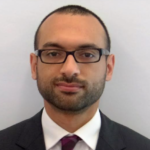Patients with arterial thrombosis or recurrent events are similarly treated with anticoagulation; however, goal INR is still uncertain because more recurrent arterial events occur with INR of 2.0–3.0, compared with venous events. Some centers recommend a goal INR of 3.0–4.0 for this group, but data are inconclusive; these patients may also be treated with combined anti-platelet and anticoagulation with warfarin with a goal INR of 2.0–3.0.6
Pregnant women with thrombotic events can be managed with therapeutic-dose LMWH, although lower doses are being used by the obstetric community with efficacy.7
As for dermatologic manifestations, low-dose aspirin and dipyridamole have been used successfully for subungual splinter hemorrhages. Digital gangrene requires full anticoagulation with heparin and/or warfarin. Iloprost and plasma exchange have been used if lesions continue to progress. Glucocorticoids and cytotoxic agents can be added in these cases for prophylaxis against aPL rebound.8
Conclusion
MORE ABOUT APS
APS should be included in the differential diagnosis when a patient presents with such dermatologic complaints as livedo reticularis. Despite not being included in the clinical criteria of APS, livedo reticularis remains the condition’s most common presenting sign. The manifestations of APS are heterogeneous, and in rare cases can include digital limb ischemia and gangrene.
Evaluation of a patient with suspected APS should include a full aPL profile, imaging and histopathology, as well as testing to exclude clinically relevant differential diagnoses. Prompt evaluation and treatment are important to prevent further thrombosis and injury.
Primary prevention of APS can include the use of aspirin, hydroxychloroquine and statins, especially in cases with concomitant SLE or hyperlipidemia, respectively. Treatment of acute thrombosis includes anticoagulation with or without antiplatelet agents, followed by long-term anticoagulation with warfarin to prevent stroke, myocardial infarction, pulmonary embolism or other complications.
 Nedal Darwish, MD, is a third-year internal medicine resident at Arnot Ogden Medical Center, Elmira, N.Y., and an incoming nephrology fellow at Baylor College of Medicine Medical Center, Houston. He has experience in clinical and academic research, having worked in microbiology and immunology, cardiology and neurology labs at NYU Langone Medical Center and SUNY Upstate Medical Center.
Nedal Darwish, MD, is a third-year internal medicine resident at Arnot Ogden Medical Center, Elmira, N.Y., and an incoming nephrology fellow at Baylor College of Medicine Medical Center, Houston. He has experience in clinical and academic research, having worked in microbiology and immunology, cardiology and neurology labs at NYU Langone Medical Center and SUNY Upstate Medical Center.
 Mohamed Manaa, MD, is a first-year internal medicine resident at Arnot Ogden Medical Center, Elmira, N.Y. He is interested in pursuing a career in rheumatology following residency.
Mohamed Manaa, MD, is a first-year internal medicine resident at Arnot Ogden Medical Center, Elmira, N.Y. He is interested in pursuing a career in rheumatology following residency.
 Griffin Reyes, MD, is an orthopedic research assistant at the University of Texas Health Science Center, Houston and an incoming preliminary surgery resident at the University of Texas Health Science Center, Houston. He is pursuing residency training in orthopedic surgery.
Griffin Reyes, MD, is an orthopedic research assistant at the University of Texas Health Science Center, Houston and an incoming preliminary surgery resident at the University of Texas Health Science Center, Houston. He is pursuing residency training in orthopedic surgery.
